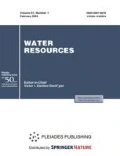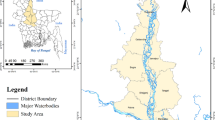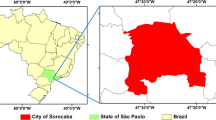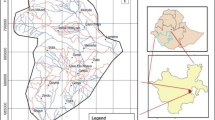Abstract
The objective of this study is to develop an anthropic exposure indicator for river basins using quantitative and qualitative aspects of the landscape and morphometric analysis based on fuzzy logic and geoprocessing. The indicator was developed from a Mamdani type fuzzy inference system by integrating information regarding the calculation of the anthropic transformation index and the circularity index of the river basin and its watersheds. The anthropic transformation was obtained from the mapping of land and forest use plotted by visual interpretation of the orthorectified multispectral satellite image of RapidEye. The circularity index was calculated using the area of the territorial limits of the study area. The basin presented thirteen classes of uses, with a greater predominance of the anthropic agricultural area, occupied by temporary crops in approximately 3472 ha (36.33%). The vegetation cover has a greater predominance of forest fragments of dense Ombrophylous forest that measure approximately 3589 ha (37.05%). The indicator showed a medium to high anthropogenic exposure for the basin. Watershed 8 showed a high to very high exposure. The exposure indicator is a tool that details the anthropic exposure of watersheds based on the reality of the activities that occur within it and the morphometric capacity. It can be used for similar areas.





Similar content being viewed by others
REFERENCES
Anomaa, G.M.M.M., Ranjith, P.U., Stephen, H.A., Claire, B., and Allen, T., Use of fuzzy rainfall–runoff predictions for claypan watersheds with conservation buffers in Northeast Missouri, J. Hydrol. (Amsterdam, Neth.), 2014, vol. 517, pp. 1008–1018.
Badar, B., Romshoo, S.A., and Khan, M.A., Integrating biophysical and socioeconomic information for prioritizing watersheds in a Kashmir Himalayan lake: a remote sensing and GIS approach, Environ. Monit. Assess., 2013, vol. 185, pp. 6419–6445.
Blum, C.T., Roderjan, C.V., and Galvão, F., Composição florística e distribuição altitudinal de epífitas vasculares da Floresta Ombrófila Densa na Serra da Prata, Morretes, Paraná, Brasil, Biota Neotr., 2012, vol. 11, pp. 141–159.
Bosa, D.M., Pacheco, D., Pasetto, M.R., and Santos, R., Florística e estrutura do componente arbóreo de uma floresta ombrófila densa montana em Santa Catarina, Brasil, Rev. Árvore, 2015, vol. 39, pp. 49–58.
Brazilian Institute of Geography and Statistics— IBGE, Manual técnico da vegetação brasileira, Rio de Janeiro: IBGE, 2012.
Brazilian Institute of Geography and Statistics— IBGE, Manual técnico de uso da terra, Rio de Janeiro: IBGE, 2013, 3 Ed.
Brazilian Institute of Geography and Statistics—IBGE, Produção Agrícola Municipal. Culturas Temporárias e permanentes, Rio de Janeiro: IBGE, 2013, vol. 40.
Cardoso, C.A., Dias, H.C.T., Soares, C.P.B., and Martins, S.V., Caracterização morfométrica da bacia hidrográfica do rio Debossan, Nova Friburgo, RJ, Rev. Árvore, 2006, vol. 30, pp. 241–248.
Chidthong, Y., Tanaka, H., and Supharatid, S., Developing ahybrid multi-model for peak floodforecasting, Hydrol. Process, 2009, vol. 23, pp. 1725–1738.
Dubreuil, V., Fante, K.P., Planchon, O., and Santanna Neto, J.L., Les types de climats annuels au Brésil: une application de la classification de Köppen de 1961 à 2015. EchoGéo, 2017, vol. 41, pp. 1–28.
Environmental Systems Research Institute—ESRI, ArcGis 10.5, 2016.
Faustino, A.B., Ramos, F.F., and Silva, S.M.P., Dinâmica temporal do uso e cobertura do solo na Bacia hidrográfica do Rio Doce (RN) com base em sensoriamento remoto e SIG: uma contribuição aos estudos ambientais, Sociedade e Território, 2014, vol. 26, pp. 18–30.
Giordano, R. and Liersch, S.L., A fuzzy GIS-based system to integrate local and technical knowledge in soil salinity monitoring, Environ. Model. Soft., vol. 36, 2012, pp. 49–63.
Gomes, H.M., Fuzzy logic for structural system control, Latin Am. J. Solids Struct., vol. 9, 2012, pp. 111–129.
Gouveia, R.G.L., Aplicação do índice de transformação antrópica na análise multitemporal da bacia do Córrego do Bezerro Vermelho em Tangará da Serra-MT, Rev. Árvore, 2013, vol. 37, pp. 1045–1054.
Güçlü, Y.S. and Şen, Z., Hydrograph estimation with fuzzy chain model, J. Hydrol. (Amsterdam, Neth.), 2016, vol. 538, pp. 587–597.
Ilaloo, M., A comparative study of fuzzy logic approach for landslide susceptibility mapping using GIS: An experience of Karaj dam basin in Iran, Procedia Social and Behavioral Sci., 2011, vol. 19, pp. 668–676.
Jacquin, A.P. and Shamseldin, A.Y., Review of the application of fuzzy inference systems in river flow forecasting, J. Hydroinf., 2009, vol. 11, pp. 202–210.
Klir, G.J., Foundations of fuzzy set theory and fuzzy logic: a historical overview, Int. J. General Syst., 2001, vol. 30, pp. 91–132.
Krueger, T., Page, T., Hubacek, K., Smith L., and Hi-scock, K., The role of expert opinion in environmental modelling, Environ. Model. Soft., 2012, vol. 36, pp. 4–18.
Lémechev, T., On hydrological heterogeneity catchment morphology and catchment response, J. Hydrol. (Amsterdam, Neth.), 1982, vol. 100, pp. 357–375.
Lohani, A.K., Kumar, R., and Sigh, R.D., Hydrological time series modeling: A comparison between adaptive neuro-fuzzy, neural network and autoregressive techniques, J. Hydrol. (Amsterdam, Neth.), 2012, vol. 442–443, pp. 23–35.
Lopes, E.R.N., Souza, J.C., Sousa, J.P.S., Albuquerque Filho, J.L., and Lourenço, R.W., Modelagem ambiental de bacias hidrográficas: caracterização morfométrica e pedológica da bacia do rio Una—Ibiúna, Brasil, Geosul, 2018, vol. 33, n. 66, pp. 105–127.
Lopes, E.R.N., Sales, J.C.A., Sousa, J.A.P., Amorim, A.T., Albuquerque Filho, J.L., and Lourenço, R.W., Losses on the Atlantic Mata Vegetation Induced by Land Use Changes, CERNE, 2018, vol. 24, no. 2, pp. 121–132.
Lourenço, R.W., Landim, P.M.B., Rosa, A.H., Roveda, J.A.F., Martins, A.C.G., and Fraceto, L.F.F., Mapping soil pollution by spatial analysis and fuzzy classification, Environ. Earth Sci., 2010, vol. 60, pp. 495–504.
Lourenço, R.W., Silva, D.C.C., Martins, A.C.G., Sales, J.C.A., Roveda, S.R.M.M., and Roveda, J.A.F., Use of fuzzy systems in the elaboration of an anthropic pressure indicator to evaluate the remaining forest fragments, Environ. Earth Sci., 2015, vol. 74, pp. 2481–2488.
Malik, M.I. and Bhat, M.S., Integrated approach for prioritizing watersheds for management: a study of lidder catchment of Kashmir Himalayas, Environ. Manag., 2014, vol. 54, pp. 1267–1287.
Moura, M.C.F. and Oliveira, L.C.S., Atividade agrícola: produção, impacto e sustentabilidade, Revista Iber-o-Americana de Ciências Ambientais, 2013, vol. 4, pp. 6–14.
Narumalani, S., Hlady, J.T., and Jensen, J.R., Information extraction from remotely sensed data, in Manual of Geospatial Sci. Technol., Bossler, J.D., Londres: Taylor & Francis, 2002, pp. 298–324.
Pereira, P., Brevik, E.C., Muñoz Rojas, M., Miller, B.A., Smetanova, A., Depellegrin, D., Misiune, L., Novara, A., and Cerda, A., Soil Mapping and Processes Modeling for Sustainable Land Management, 2017.
Pradhan, B., Use of GIS-based fuzzy logic relations and its cross application to produce landslide susceptibility maps in three test areas in Malaysia, Environ. Earth Sci., 2011, vol. 63, pp. 329–349.
Reid, L.M., Understanding and evaluating cumulative watershed impacts, in Cumulative Watershed Effects of Fuel Management in the Western United States, Elliot, W.J., Miller, I.S., and Audin, L., United States Department of Agriculture Forest Service, Rocky Mountain Research Station, Fort Collins, CO, General Tech. Rep. RMRS-GTR-231, 2010, pp. 277–298.
Rodrigues, C.A.G. and Hott, M.C., Dinâmica da vegetação natural no nordeste do estado de São Paulo, entre 1988 e 2003, Rev. Árvore, 2010, vol. 34, pp. 881–887.
Rodrigues, L.C., Neves, S.M.A.S., Neves, R.J., Galvanin, E.A.S., and Silva, J.S.V., Avaliação do grau de transformação antrópica da paisagem da bacia do rio Queima-Pé, Mato Grosso, Brasil, Revista Brasileira de Ciências Ambientais, 2014, no. 32, pp. 52–64.
Roy, J. and Saha, S., GIS-based gully erosion susceptibility evaluation using frequency ratio, cosine amplitude and logistic regression ensembled with fuzzy logic in Hinglo River Basin, India, Remote Sens. Applic.: Soc. Environ., 2019, vol. 15, pp. 1–15.
Seabra, V.S., Xavier, R.A., Damasceno, J., and Dornellas, P.C., Mapeamento do uso e cobertura do solo da bacia do rio Taperoá: região semiárida do estado da Paraíba, Caminhos de Geografia, 2014, vol. 15, no. 50, pp. 127–137.
Silvert, W., Índices fuzzy environment conditions, Ecol. Model., 2000, vol. 130, pp. 111–119.
Souza, J.C., Sales, J.C.A., Lopes, E.R.N., Rove-da, J.A.F., Roveda, S.R.M.M., and Lourenço, R.W., Valuation methodology of laminar erosion potential using fuzzy inference systems in a Brazilian savanna, Environ. Monit. Assess., 2019, pp. 191–624.
The Mathworks. Fuzzy Logic Toolbox™ User’s Guide, Copyright 1995–2014 by The MathWorks Inc., 2014.
Tonello, K.C., Dias, H.C.T., Souza, A.L., Ribeiro, C.A.A.S., and Leite, F.P., Morfometria da bacia hidrográfica da Cachoeira das Pombas, Guanhães – MG, Rev. Árvore, 2006, vol. 30, pp. 849–857.
Vaeza, R.F., Filho, Oliveira Filho, P.C., Maia, A.G., and Disperati, A.A., Uso e ocupação do solo em bacia hidrográfica urbana a partir de imagens orbitais de alta resolução, Floresta e Ambiente, 2010, vol. 17, pp. 23–29.
Zadeh, L.A., Fuzzy sets. Information and control, 1965, vol. 8, pp. 338–353.
Author information
Authors and Affiliations
Corresponding authors
Rights and permissions
About this article
Cite this article
Elfany Reis do Nascimento Lopes, Carlos de Souza, J., Paixão de Sousa, J.A. et al. Anthropic Exposure Indicator for River Basins Based on Landscape Characterization and Fuzzy Inference. Water Resour 48, 29–40 (2021). https://doi.org/10.1134/S0097807821010140
Received:
Revised:
Accepted:
Published:
Issue Date:
DOI: https://doi.org/10.1134/S0097807821010140




